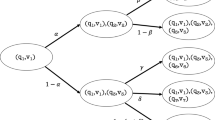Abstract
In this paper we discuss two approaches to the axiomatization of scientific theories in the context of the so called semantic approach, according to which (roughly) a theory can be seen as a class of models. The two approaches are associated respectively to Suppes’ and to da Costa and Chuaqui’s works. We argue that theories can be developed both in a way more akin to the usual mathematical practice (Suppes), in an informal set theoretical environment, writing the set theoretical predicate in the language of set theory itself or, more rigorously (da Costa and Chuaqui), by employing formal languages that help us in writing the postulates to define a class of structures. Both approaches are called internal, for we work within a mathematical framework, here taken to be first-order ZFC. We contrast these approaches with an external one, here discussed briefly. We argue that each one has its strong and weak points, whose discussion is relevant for the philosophical foundations of science.
Similar content being viewed by others
References
Andréka, H., Madarász, J. X., Németi, I. & Székely, G. (2010). A logic road from special relativity to general relativity, http://arxiv.org/abs/1005.0960.
Bourbaki, N. (1968). Theory of sets. Reading: Hermann & Addicon Wesley.
Brignole D., da Costa N. C. A. (1971) On supernormal Ehresmann-Dedecker universes. Mathematische Zeitschrift 122: 342–350
da Costa N. C. A., Chuaqui R. (1988) On Suppes’ Set theoretical predicates. Erkenntnis 29: 95–112
da Costa, N. C. A., & Krause, D. (forthcoming). Physics, inconsistency, and quasi-truth.
da Costa, N. C. A., Krause, D., & Bueno, O. (2007). Paraconsistent logics and paraconsistency. In D. Jacquette (Ed.), Philosophy of logic, Vol. 5 of D. M. Gabbay, P. Thagard & J. Woods (Eds.), Handbook of the philosophy of science (pp. 655–781).
da Costa N. C. A., Rodrigues A. A. M. (2007) Definability and invariance. Studia Logica 82: 1–30
French, S. & Krause, D. (2010). Remarks on the theory of quasi-sets, Studia Logica, Online.
Hodges W. (2001) Elementary predicate logic. In: Gabbay D. M., Guenthner F. (eds) Handbook of philosophical logic, Vol. 1, 2nd ed. Springer, Berlin
Kaye R. (1991) Models of Peano arithmetic. Clarendon Press, Oxford
Kunen K. (2009) The foundations of mathematics. College Publications, London
Ludwig G. (1985) An axiomatic basis for quantum mechanics, Vol. I. Springer, Berlin
Maitland Wright J. D. (1973) All operators on a Hilbert space are bounded. Bulletin of the American Mathematical Society 79(6): 1247–1250
McKinsey J. C. C., Sugar A. C., Suppes P. (1953) Axiomatic foundations of classical particle mechanics. Journal of Rational Mechanics and Analysis 2(2): 253–272
Moore G. H. (1980) Beyond first-order logic: The historical interplay between mathematical logic and axiomatic set theory. History and Philosophy of Logic 1: 95–137
Muller, F. A. (2009). Reflections on the revolution at Stanford. Synthese. doi:10.1007/s11229-009-9669-7.
Shapiro S. (1991) Foundations without foundationalism, a case for second-order logic. Clarendon Press, Oxford
Suppes P. (1957) Introduction to logic. van Nostrand, New York
Suppe, F. (ed.) (1977) The structure of scientific theories, 2nd ed. Chicago University Press, Urbana, Chigago
Suppes T. (2002) Representation and invariance of scientific structures. Center for the Study of Language and Information, Stanford
Suppes, P. (2009). Future developments of scientific structures closer to experiments: Response to F. A. Muller. Synthese. doi:10.1007/s11229-009-9670-1.
Author information
Authors and Affiliations
Corresponding author
Rights and permissions
About this article
Cite this article
Krause, D., Arenhart, J.R.B. & Moraes, F.T.F. Axiomatization and Models of Scientific Theories. Found Sci 16, 363–382 (2011). https://doi.org/10.1007/s10699-011-9226-y
Published:
Issue Date:
DOI: https://doi.org/10.1007/s10699-011-9226-y




